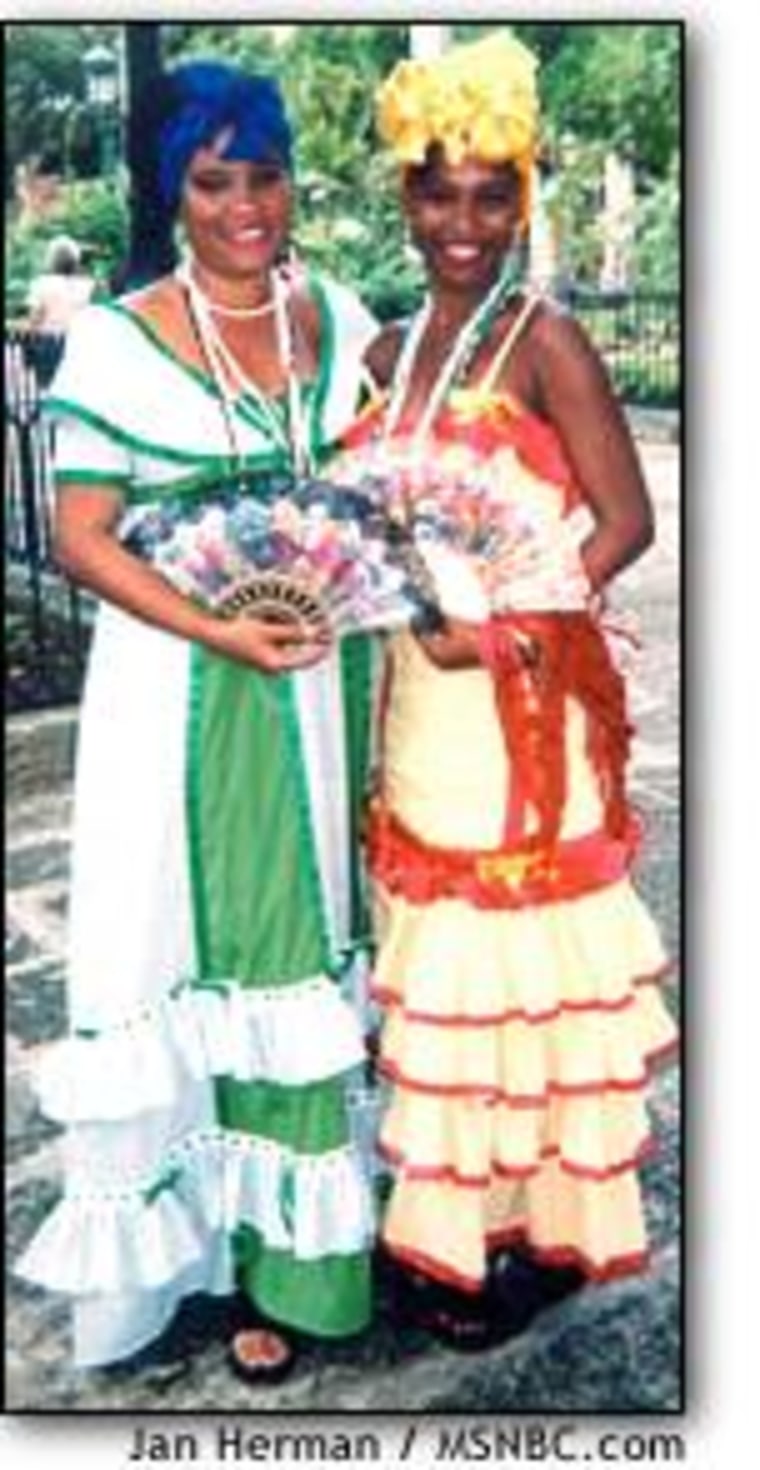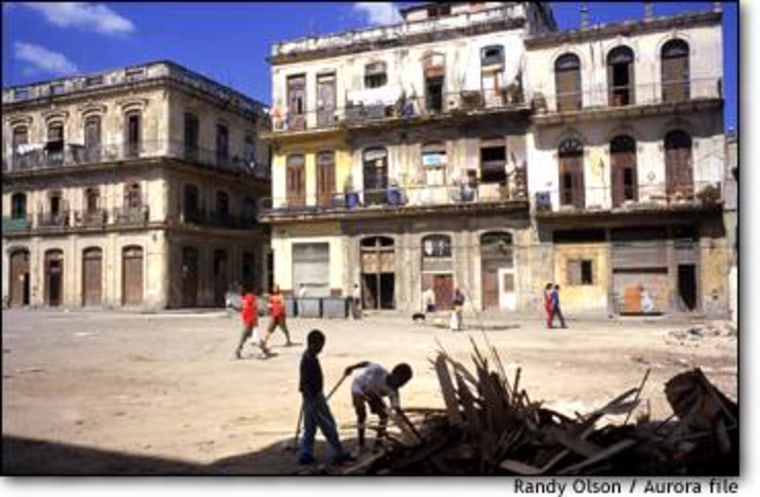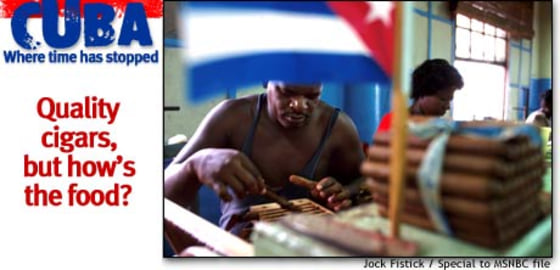The pleasures of Cuba are many — music, dancing, art, history, cigars, rum, sexy men and women — but fine dining is not one of them. The food I ate was tasty (leagues beyond, say, Czechoslovakian cuisine). But we were invariably served a monotonous diet of the “Cuban trilogy,” our tour leader’s phrase for chicken, pork or fish (always red snapper).
EVEN AT THE PALADARS — the restaurants set up in private homes, which are regarded as the best places to eat and which cater to tourists — there is almost no escaping the Cuban trilogy.
We did have lobster for lunch at “1830,” a modestly elegant, waterfront restaurant in Havana, which was very well prepared and served in high style. Also, I do remember eating a slice or two of so-called pizza. And our farewell dinner at the Nacional, which offered steak on the menu, qualified as grand.
But gourmets and gourmands should check their expectations at passport control. That goes double for vegetarians. The lone vegetarian in our group had even less variety to choose from than the rest of us.
Blame the food shortages and the rationing on government policies that have more or less bankrupted the Cuban economy or blame the U.S. embargo, which is designed to ruin it, or blame both. I don’t hold Fidel personally responsible for the intestinal parasite (giardia) I brought back with me. I blame it on the ice cubes I forgot to take out of the many mojitos I drank. (What a dummy. Everybody said, “Don’t drink the water.”) But when it comes to shortages of food or basic medicines (like aspirin) and school supplies (like pencils and paper), who else is to blame if not the Cuban government and the U.S. embargo?

Because an infusion of hard currency was the quickest way to boost an economy crippled by the collapse of the Soviet Union in 1989 — more than a decade later, Cuba is still trying to recuperate from the loss of Soviet subsidies — the Castro government finally decided to encourage tourism and foreign investment, and in 1993 legalized the use of U.S. dollars.
During the early ’90s, when shortages were at their worst (an emergency officially termed the Special Period in a Time of Peace), the government not only allowed Cubans to have dollars; it established state-owned dollar stores to sell goods. The dollar has since become the major Cuban currency, which makes things convenient for American tourists. In fact, they must use dollars throughout the island at any establishment, state-owned or otherwise.
What is not convenient for U.S. tourists is that they can’t use their credit cards or travelers checks, unless they’re drawn on non-U.S. banks. So it’s necessary to bring cash — preferably in small denominations to make transactions easier.
Black-market cigars
Cubans who can tap into the dollar economy are much better off than those who can’t. So it’s not unusual to come across professionals working as cab drivers, waiters, hotel clerks and musicians, or in other tourist-related jobs.
Hustling black-market cigars is another way for Cubans to make a living from tourists. It’s safe to say that anyone who looks like a foreigner has been approached on the street with offers of the best brands at cut-rate prices. And there isn’t a brand that isn’t hawked — by the boxful — from Cohiba and Montecristo to Romeo y Julieta and H. Upmann.

No visit to the island would be complete without buying cigars. But don’t buy them from the hustlers. All Cuban cigars are hand made in state-owned factories and sold in state-owned cigar shops. And everyone I spoke to — cigar experts, tourist guides, travel agents, and longtime Havana residents — warns that the cigars being hawked on the street are always fakes. They may be hand made. They may be Cuban. But they’re not what their labels claim them to be.
It’s a tricky business. A tour of the Corona cigar factory, the largest and most prestigious in Havana (down the street from the Parque Central hotel), showed just how tricky. When you enter the factory, you can’t bring in cameras or bags, and you’re warned not to speak with any of the workers. But there, even under the watchful eye of state security guards, I was approached three times to make an illicit purchase.
One worker put a pair of cigars he had just rolled on his table and indicated that they were for me. Another offered me a neatly tied handful of a dozen cigars in plain sight of anyone who cared to look. I hadn’t the faintest idea of how either of them expected to close the deal without getting caught. And I didn’t want to find out. A third factory worker, standing in a doorway out of sight of the guards, took an entire box of cigars from behind his back and offered it to me.
HUSTLING THE REAL THING
I have no doubt the rollers were hustling the genuine article, unless they substituted fakes by sleight of hand. And since cigar rollers who meet their daily quotas are allowed to take home three cigars for their own use at the end of their shift — two cigars in the pocket and one, smoking, in the mouth — some of the best Cuban cigars must get onto the black market. After all, the Corona factory alone produces five million hand-made cigars a year. That means a lot of bonus cigars in the pocket and out the door.
Even so, it’s more fun to take the factory tour and make your legal purchase at the store, where the quality of the cigars is beyond question and where the clerks are happy to mark your $350 box with an official $55 receipt. (Americans are allowed to bring $100 worth of Cuban cigars per person into the U.S.)

A great advantage, not to mention the camaraderie, of traveling with a group that has a common interest — ours was the island’s music — is the clout to arrange behind-the-scenes demonstrations and expert lectures ordinarily unavailable to individual tourists. We were plied with information not only about the fascinating history of traditional and popular Cuban music (the latest trend, Cuban rap, excepted), but also about the city itself and the task of restoring its architectural heritage.
The lectures deepened our understanding immeasurably — and our pleasure. When we listened to the various musical forms, our appreciation was far more astute than it otherwise would have been. And when it came to dancing in the clubs, our rhythmically challenged group dared the impossible. After a rooftop lesson in the basic moves, we forgot our inhibitions and stepped out side by side with Cubans who seemed born to dance.
